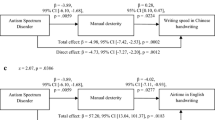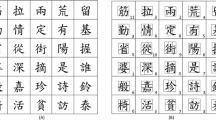Abstract
Handwriting is commonly identified as an area of weakness in children with autism spectrum disorder (ASD), but precise deficits have not been fully characterised. Boys with ASD (n = 23) and matched controls (n = 20) aged 8–12 years completed a simple, digitised task to objectively assess handwriting performance using advanced descriptive measures. Moderate to large associations were identified between handwriting performance and attention, ASD symptoms and motor proficiency. The ASD group demonstrated significantly less smooth movements and significantly greater sizing variability and peak velocity relative to controls. These findings provide a clearer indication of the specific nature of handwriting impairments in children with ASD, and suggest a relationship with core clinical symptom severity, attention and motor behaviours.


Similar content being viewed by others
References
Adi-Japha, E., Landau, Y., Frenkel, L., Teicher, M., Gross-Tsur, V., & Shalev, R. (2007). ADHD and dysgraphia: Underlying mechanisms. Cortex, 43(6), 700–709. doi:10.1016/S0010-9452(08)70499-4.
Alaniz, M. L., Galit, E., Necesito, C. I., & Rosario, E. R. (2015). Hand strength, handwriting, and functinoal skills in children with autism. American Journal of Occupational Therapy, 69, 6904220030. doi:10.5014/ajot.2015.016022.
American Psychiatric Association (2013). Diagnostic and statistical manual of mental disorders (5th edn.). Washington, DC: American Psychiatric Publishing.
Ashburner, J., Rodger, S., Ziviani, J., & Jones, J. (2014). Occupational therapy services for people with autism spectrum disorder: Current state of play, use of evidence and future learning priorities. Australian Occupational Therapy Journal, 61, 110–120. doi:10.1111/1440-1630.12083.
Cartmill, L., Rodger, S., & Ziviani, J. (2009). Handwriting of eight-year-old children with autistic spectrum disorder: An exploration. Journal of Occupational Therapy, Schools, & Early Intervention, 2(2), 103–118. doi:10.1080/19411240903146426.
Church, C., Alisanski, S., & Amanullah, S. (2000). The social, behavioural, and academic experiences of children with Asperger syndrome. Focus on Autism and Other Developmental Disabilities, 15(1), 12–20. doi:10.1177/108835760001500102.
Cohen, J. (1988). Statistical power analysis for the behavioural sciences (2nd edn.). Hillsdale, NJ: Lawrence Erlbaum Associates.
Constantino, J. N., & Gruber, C. P. (2012). Social Responsiveness Scale, Second Edition. Los Angeles, CA: Western Psychological Services.
David, F., Baranek, G., Wiesen, C., Miao, A., & Thorpe, D. (2012). Coordination of precision grip in 2–6 year old children with autism spectrum disorders compared to children developing typically and children with developmental disabilities. Frontiers in Integrative Neuroscience, 6, 122. doi:10.3389/fnint.2012.00122.
Dennis, J. L., & Swinth, Y. (2001). Pencil grasp and children’s handwritnig legibility during different-length writing tasks. American Journal of Occupational Therapy, 55, 175–183.
DiCicco-Bloom, E., Lord, C., Zwaigenbaum, L., Courchesne, E., Dager, S. R., Schmitz, C., Young, L. J. (2006). The developmental neurobiology of autism spectrum disorder. The Journal of Neuroscience, 26(26), 6897–6906. doi:10.1523/JNEUROSCI.1712-06.2006.
Dowd, A., McGinley, J., Taffe, J., & Rinehart, N. J. (2012). Do planning and visual integration difficulties underpin motor dysfunction in autism? A kinematic study of young children with autism. Journal of Autism & Developmental Disorders, 42(8), 1539–1548. doi:10.1007/s10803-011-1385-8.
Falk, T., Tam, C., Schellnus, H., & Chau, T. (2011). On the development of a computer-based handwriting assessment tool to objectively quantify handwriting proficiency in children. Computer Methods and Programs in Biomedicine, 104(3), e102–e111. doi:10.1016/j.cmpb.2010.12.010.
Feder, K. P., & Majnemer, A. (2007). Handwriting development, competency, and intervention. Developmental Medicine and Child Neurology, 49(4), 312–317. doi:10.1111/j.1469-8749.2007.00312.x.
Fernell, E., Hedvall, Å., Norrelgen, F., Eriksson, M., Höglund-Carlsson, L., Barnevik-Olsson, M., Gillberg, C. (2010). Developmental profiles in preschool children with autism spectrum disorders referred for intervention. Research in Developmental Disabilities, 31(3), 790–799. doi:10.1016/j.ridd.2010.02.003.
Flapper, B., Houwen, S., & Schoemaker, M. (2006). Fine motor skills and effects of methylphenidate in children with attention-deficit-hyperactivity disorder and developmental coordination disorder. Developmental Medicine and Child Neurology, 48, 165–169.
Fournier, K. A., Hass, C. J., Naik, S. K., Lodha, N., & Cauraugh, J. H. (2010). Motor coordination in autism spectrum disorders: A synthesis and meta-analysis. Journal of Autism and Developmental Disorders, 40(10), 1227–1240. doi:10.1007/s10803-010-0981-3.
Freitag, C. M., Kleser, C., Schneider, M., & Von Gontard, A. (2007). Quantitative assessment of neuromotor function in adolescents with high functioning autism and Asperger syndrome. Journal of Autism and Developmental Disorders, 37(5), 948–959. doi:10.1007/s10803-006-0235-6.
Fuentes, C. T., Mostofsky, S. H., & Bastian, A. J. (2009). Children with autism show specific handwriting impairments. Neurology, 73(19), 1532–1537. doi:10.1212/WNL.0b013e3181c0d48c.
Germain, B., Eppinger, M., Mostofsky, S., DiCicco-Bloom, E., & Maria, B. (2015). Recent advances in understanding and managing autism spectrum disorders. Journal of Child Neurology, 30(14), 1887–1920. doi:10.1177/0883073815601499.
Gillberg, C., & Fernell, E. (2014). Autism plus versus autism pure. Journal of Autism and Developmental Disorders, 44, 3274–3276. doi:10.1007/s10803-014-2163-1.
Green, D., Charman, T., Pickles, A., Chandler, S., Loucas, T., Simonoff, E., & Baird, G. (2009). Impairment in movement skills of children with autistic spectrum disorders. Developmental Medicine & Child Neurology, 51(4), 311–316. doi:10.1111/j.1469-8749.2008.03242.x.
Hardan, A. Y., Kilpatric, M., Keshavan, M. S., & Minshew,. J. (2003). Motor performance and anatomic magnetic respnance imaging (MRI) of the basal ganglia in autism. Journal of Child Neurology, 18(5), 317–324.
Hellinckx, T., Roeyers, H., & Waelvelde, H. V. (2013). Predictors of handwriting in children with autism spectrum disorder. Research in Autism Spectrum Disorders, 7(1), 176–186. doi:10.1016/j.rasd.2012.08.009.
Henderson, S., Sugden, D., & Barnett, A. (2007). Movement assessment battery for children-2 s edition (Movement ABC-2). London: The Psychological Corporation.
Hilton, C., Wente, L., LaVesser, P., Ito, M., Reed, C., & Herzberg, G. (2007). Relationship between motor skill impairment and severity in children with Asperger syndrome. Research in Autism Spectrum Disorders, 1(4), 339–349. doi:10.1016/j.rasd.2006.12.003.
Johnson, B. P., Papadopoulos, N., & Fielding, J. (2013a). A quantitative comparison of handwriting in children with high-functioning autism and attention deficit hyperactivity disorder. Research in Autism Spectrum Disorders. 7, 1638–1646. doi:10.1016/j.rasd.2013.09.008.
Johnson, B. P., Phillips, J., Papadopoulos, N., Fielding, J., Tonge, B. J., & Rinehart, N. J. (2013b). Understanding macrographia in children with autism spectrum disorders. Research in Developmental Disabilities, 34(9), 2917–2926. doi:10.1016/j.ridd.2013.06.003.
Kopp, S., Beckung, E., & Gillberg, C. (2010). Developmental coordination disorder and other motor control problems in girls with autism spectrum disorder and/or attention-deficit/hyperactivity disorder. Research in Developmental Disabilities, 31(2), 350–361. doi:10.1016/j.ridd.2009.09.017.
Kushki, A., Chau, T., & Anagnostou, E. (2011). Handwriting difficulties in children with autism spectrum disorders: A scoping review. Journal of Autism and Developmental Disorders, 41(12), 1706–1716. doi:10.1007/s10803-011-1206-0.
Mari, M., Castiello, U., Marks, D., Marraffa, C., & Prior, M. (2003). The reach-to-grasp movement in children with autism spectrum disorder. Philosophical Transactions of the Royal Society of London. Series B, Biological Sciences, 358(1430), 393–403. doi:10.1098/rstb.2002.1205.
Matson, J., & Konst, M. (2014). Early intervention for autism: Who provides treatment and in what settings. Research in Autism Spectrum Disorders, 8, 1585–1590.
Mayes, S., & Calhoun, S. (2007). Learning, attention, writing, and processing speed in typical children and children with ADHD, autism, anxiety, depression, and oppositional-defiant disorder. Child Neuropsychology, 13(6), 469–493. doi:10.1080/09297040601112773.
Minshew, N. J., Goldstein, G., & Siegel, D. J. (1997). Neuropsychologic functioning in autism: Profile of a complex information processing disorder. Journal of the International Neuropsychological Society, 3, 303–316.
Miyahara, M., Piek, J., & Barrett, N. (2008). Effect of postural instability on drawing errors in children: A synchronized kinematic analysis of hand drawing and body motion. Human Movement Science, 27(5), 705–713. doi:10.1016/j.humov.2008.03.001.
Nickel, L. R., Thatcher, A. R., Keller, F., Wozniak, R. H., & Iverson, J. M. (2013). Posture developmen in infants at heightened vs. low risk for autism spectrum disorders. Infancy, 18(5). Doi:10.1111/infa.12025.
Papadopoulos, N., McGinley, J., Tonge, B. J., Bradshaw, J., Saunders, K., Murphy, A., & Rinehart, N. J. (2012). Motor proficiency and emotional/behavioural disturbance in autism and Asperger’s disorder: Another piece of the neurological puzzle? Autism: the international journal of research and practice, 16, 627–640. doi:10.1177/1362361311418692.
Papadopoulos, N., McGinley, J., Tonge, B. J., Bradshaw, J., Saunders, K., & Rinehart, N. J. (2011). An investigation of upper limb motor function in high functioning autism and Asperger’s disorder using a repetitive Fitts’ aiming task. Research in Autism Spectrum Disorders, 6(1), 286–292. doi:10.1016/j.rasd.2011.05.010.
Rinehart, N. J., Bellgrove, M., Tonge, B. J., Brereton, A., Howells-Rankin, D., & Bradshaw, J. (2006). An examination of movement kinematics in young people with high-functioning autism and Asperger’s disorder: Further evidence for a motor planning deficit. Journal of Autism and Developmental Disorders, 36(6), 757–767. doi:10.1007/s10803-006-0118-x.
Rinehart, N. J., Bradshaw, J., Brereton, A., & Tonge, B. J. (2001). Movement preparation in high-functioning autism and Asperger disorder: A serial choice reaction time task involving motor reprogramming. Journal of Autism and Developmental Disorders, 31(1), 79–88. doi:10.1023/A:1005617831035.
Rodger, S., Ashburner, J., Cartmill, L., & Bourke-Taylor, H. (2010). Helping children with autism spectrum disorders and their families: Are we losing our occupation-centred focus? Australian Occupational Therapy Journal, 57, 276–280. doi:10.1111/j.1440-1630.2010.00877.x.
Rodger, S., & Polatajko, H. (2014). Occupational therapy for children with autism. In V. Patel (Ed.), Comprehensive guide to autism (pp. 2297–2314). New York: Springer Science and Business Media. doi:10.1007/978-1-4614-4788-7.
Rosenblum, S., Ben Simhon, H., & Gal, E. (2015). Unique handwriting performance characteristics of children with high-functioning autism spectrum disorder. Research in Autism Spectrum Disorders, 23, 235–244. doi:10.1016/j.rasd.2015.11.004.
Sacrey, L., Germani, T., Bryson, S., & Zwaigenbaum, L. (2014). Reaching and grasping in autism spectrum disorder: A review of recent literature. Frontiers in Neurology, 5, 6. doi:10.3389/fneur.2014.00006.
Smits-Engelsman, B., & Van Galen, G. (1997). Dysgraphia in children: Lasting psychomotor deficiency or transient developmental delay? Journal of Experimental Child Psychology, 67(2), 164–184. doi:10.1006/jecp.1997.2400.
Sprenger, L., Buhler, E., Poutska, L., Bach, C., Heinzel-Gutenbrunner, M., Kamp-Becker, I., & Bachmann, C. (2013). Impact of ADHD symptoms on autism spectrum disorder symptom severity. Research in Developmental Disabilities, 34, 3545–3552. doi:10.1016/j.ridd.2013.07.028.
Sturm, H., Fernell, E., & Gillberg, C. (2004). Autism spectrum disorders in children with normal intellectual levels: Associated impairments and subgroups. Developmental Medicine & Child Neurology, 46(7), 444–447. doi:10.1111/j.1469-8749.2004.tb00503.x.
Swanson, J. M., Schuck, S., Porter, M. M., Carlson, C., Hartman, C. A., Sergeant, J. A., & Wigal, T (2012). Categorical and dimensional definitions and evaluations of symptoms of ADHD: History of the SNAP and the SWAN rating scales. International Journal of Educational and Psychological Assessment, 10(1), 51–70.
Volkmar, F. R. (2014). Editorial: The importance of early intervention. Journal of Autism and Developmental Disorders, 44(12), 2979–2980. doi:10.1007/s10803-014-2265-9.
Volkmar, F. R., & McPartland, J. C. (2015). Moving beyond a categorical diagnosis of autism. The Lancet Neurology, 4422(15), 9–10. doi:10.1016/S1474-4422(15)00299-9.
Wechsler, D. (2011). The Wechsler abbreviated scale of intelligence, second edition (WASI-II). Bloomington, MN: NCS Pearson.
Zachor, D. A., & Ben Itzchak, E. (2010). Treatment approach, autism severity and intervention outcomes in young children. Research in Autism Spectrum Disorders, 4(3), 425–432. doi:10.1016/j.rasd.2009.10.013.
Ziviani, J., & Elkins, J. (1986). Effects of pencil frip on handwriting speed and legibility. Education Review, 38, 247–257.
Acknowledgements
Peter G Enticott is supported by a Career Development Fellowship from the National Health and Medical Research Council (Australia). Beth P Johnson is supported by a Peter Doherty - Australian Biomedical Fellowship from National Health and Medical Research Council (Australia). Nicole J Rinehart is a recipient of project grants (#1004387 and #436609) from the National Health and Medical Research Council (Australia).
Authors’ Contributions
NG conceived of the study, participated in its design and coordination, performed the measurement, performed the statistical analysis and drafted the manuscript; BPJ participated in the design and interpretation of the data; PGE participated in the design and coordination of the study and helped with interpretation of the data; NJR participated in the design and coordination of the study and helped with interpretation of the data. All authors read, contributed to and approved the final manuscript.
Author information
Authors and Affiliations
Corresponding author
Ethics declarations
Conflict of interest
The authors declare that they have no conflicts of interest.
Ethical Approval
All procedures performed in this study were in accordance with the ethical standards of the Human Research Ethics Committee of Monash and Deakin Universities, Melbourne, Australia, and with the 1964 Helsinki declaration and its later amendments or comparable ethical standards. This article does not contain any studies with animals performed by any of the authors. Informed consent was obtained from all participants included in the study.
Rights and permissions
About this article
Cite this article
Grace, N., Enticott, P.G., Johnson, B.P. et al. Do Handwriting Difficulties Correlate with Core Symptomology, Motor Proficiency and Attentional Behaviours?. J Autism Dev Disord 47, 1006–1017 (2017). https://doi.org/10.1007/s10803-016-3019-7
Published:
Issue Date:
DOI: https://doi.org/10.1007/s10803-016-3019-7




